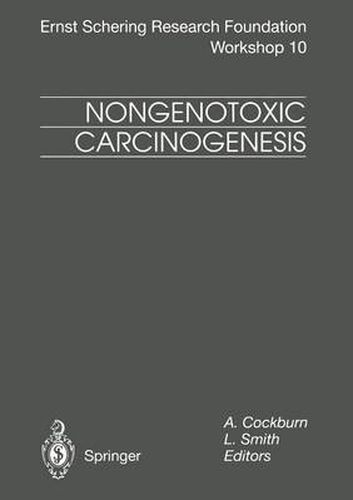Readings Newsletter
Become a Readings Member to make your shopping experience even easier.
Sign in or sign up for free!
You’re not far away from qualifying for FREE standard shipping within Australia
You’ve qualified for FREE standard shipping within Australia
The cart is loading…






This title is printed to order. This book may have been self-published. If so, we cannot guarantee the quality of the content. In the main most books will have gone through the editing process however some may not. We therefore suggest that you be aware of this before ordering this book. If in doubt check either the author or publisher’s details as we are unable to accept any returns unless they are faulty. Please contact us if you have any questions.
What is a nongenotoxic carcinogen? This question recurred through out the Ernst Schering Research Foundation Workshop on nongeno toxic carcinogenesis, underlining the complexity of the topic. The clarity of the view that all carcinogens act by mutating DNA, origin ally advocated by Bruce Ames nearly 20 years ago, has been clouded by the increasing numbers of compounds which are not genotoxic but which nevertheless can cause cancer. There is an urgent need to in crease our understanding of these compounds so that their risks can be evaluated realistically and decisions made from a position of knowl edge and strength, rather than in fear of the unknown. A nongenotoxic carcinogen can be defined as a compound which causes cancer, but which does not cause damage to DNA as its primary biological activity. This negative definition covers a range of carci nogens acting through a variety of mechanisms. Such chemicals often produce tumours only in a single organ species, and there are a few common locations which are affected most often. For example, in male rats, certain carcinogens bind to az globulin to form a complex which 11 accumulates in the kidney tubular cells, which is followed by necrosis and compensatory cell proliferation leading the neoplasia. Other com mon mechanisms include hormonal imbalance resulting in thyroid tu mours or peroxisome proliferation resulting in liver cancer. These and other examples are studied in some detail in the papers of this book.
$9.00 standard shipping within Australia
FREE standard shipping within Australia for orders over $100.00
Express & International shipping calculated at checkout
This title is printed to order. This book may have been self-published. If so, we cannot guarantee the quality of the content. In the main most books will have gone through the editing process however some may not. We therefore suggest that you be aware of this before ordering this book. If in doubt check either the author or publisher’s details as we are unable to accept any returns unless they are faulty. Please contact us if you have any questions.
What is a nongenotoxic carcinogen? This question recurred through out the Ernst Schering Research Foundation Workshop on nongeno toxic carcinogenesis, underlining the complexity of the topic. The clarity of the view that all carcinogens act by mutating DNA, origin ally advocated by Bruce Ames nearly 20 years ago, has been clouded by the increasing numbers of compounds which are not genotoxic but which nevertheless can cause cancer. There is an urgent need to in crease our understanding of these compounds so that their risks can be evaluated realistically and decisions made from a position of knowl edge and strength, rather than in fear of the unknown. A nongenotoxic carcinogen can be defined as a compound which causes cancer, but which does not cause damage to DNA as its primary biological activity. This negative definition covers a range of carci nogens acting through a variety of mechanisms. Such chemicals often produce tumours only in a single organ species, and there are a few common locations which are affected most often. For example, in male rats, certain carcinogens bind to az globulin to form a complex which 11 accumulates in the kidney tubular cells, which is followed by necrosis and compensatory cell proliferation leading the neoplasia. Other com mon mechanisms include hormonal imbalance resulting in thyroid tu mours or peroxisome proliferation resulting in liver cancer. These and other examples are studied in some detail in the papers of this book.